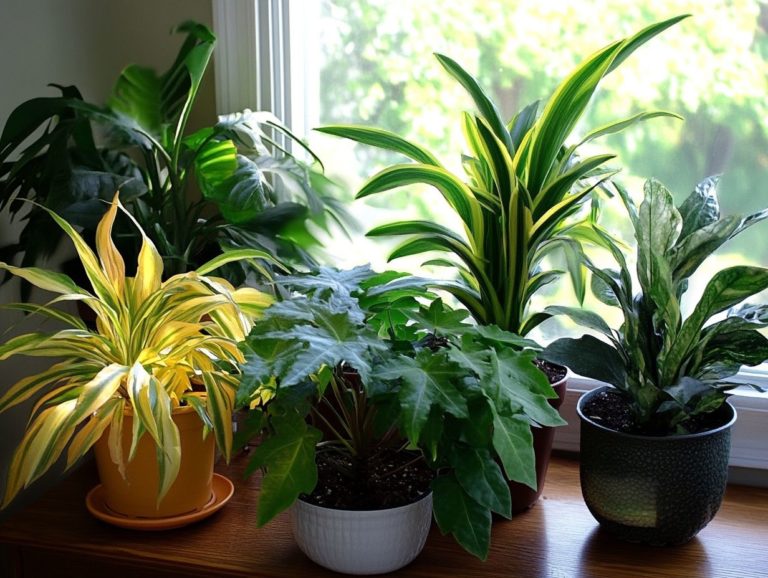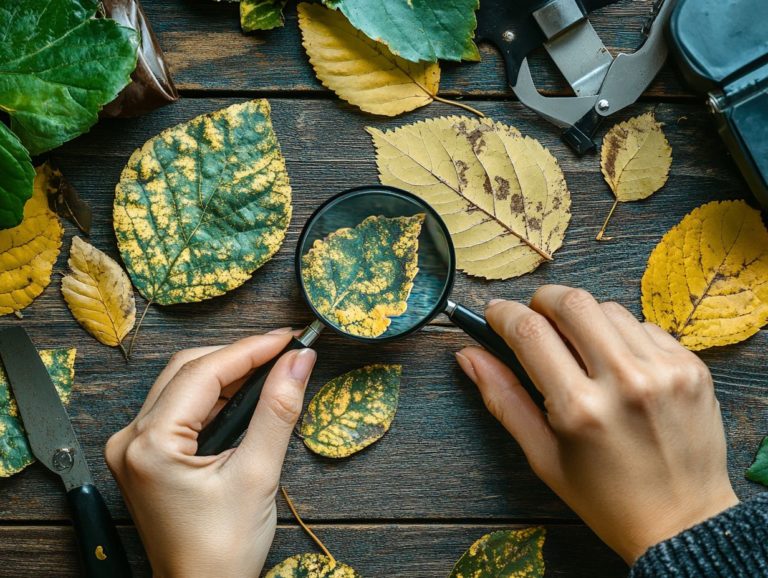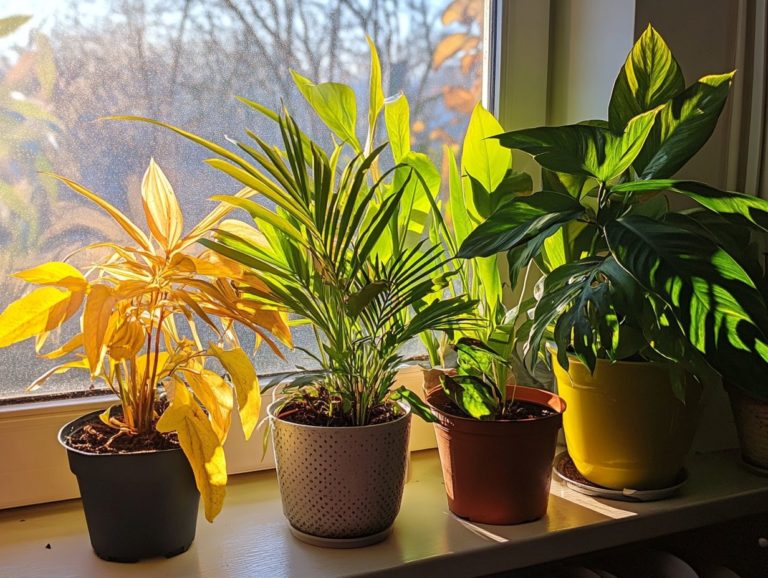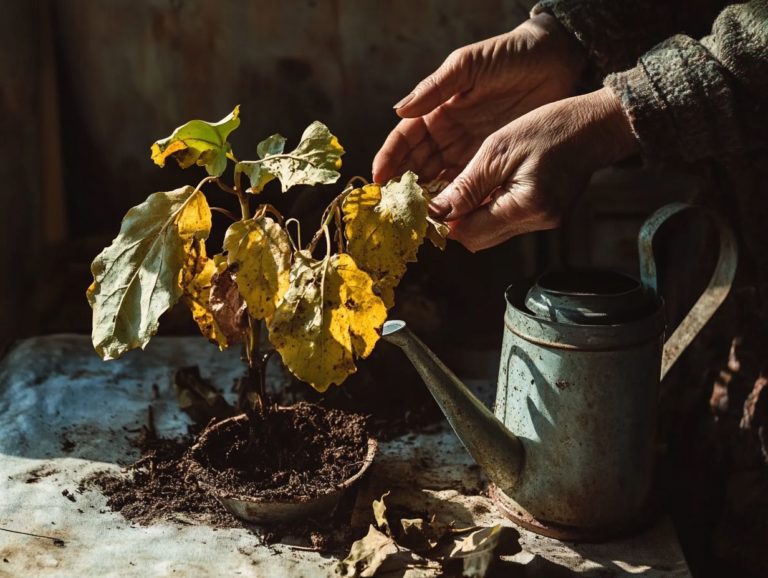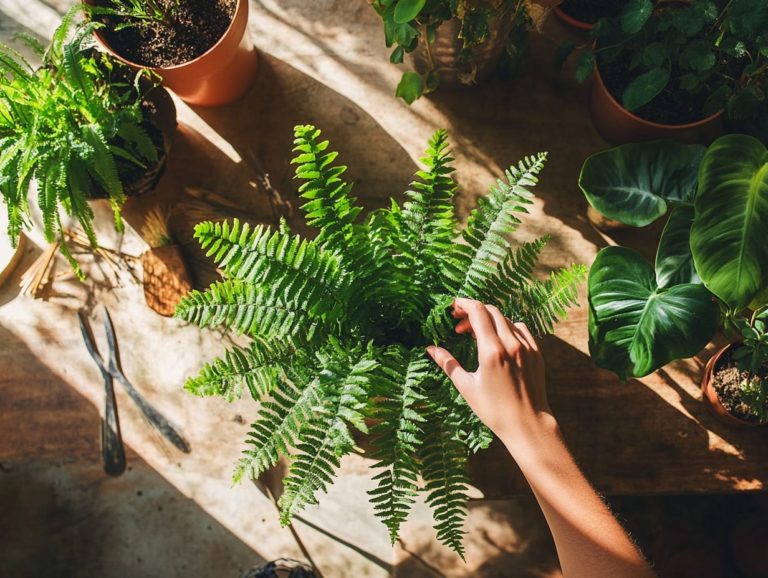5 Common Issues with Fiddle Leaf Figs
If you’re the proud owner of a Fiddle Leaf Fig, these plants are stunning, but they can be tricky to care for.
This guide dives into five common issues that could impact your beloved Fiddle Leaf Fig: overwatering, underwatering, nutrient deficiencies, pests and diseases, and environmental factors.
Within these pages, you’ll discover best practices for optimal care, effective watering tips, insights into the nutrients your plant craves, and guidance on how to identify and tackle potential problems. Whether you’re a seasoned plant parent or just starting on your green journey, you ll find invaluable advice to help your Fiddle Leaf Fig flourish.
Contents
- Key Takeaways:
- 1. Overwatering
- 2. Underwatering
- 3. Lack of Nutrients
- 4. Pests and Diseases
- 5. Environmental Factors
- How to Properly Care for a Fiddle Leaf Fig Plant?
- What Are the Best Practices for Watering a Fiddle Leaf Fig?
- What Are the Most Common Nutrient Deficiencies in Fiddle Leaf Figs?
- How Can One Identify and Treat Pests and Diseases in Fiddle Leaf Figs?
- What Are the Ideal Growing Conditions for Fiddle Leaf Figs?
- What Are Some Common Mistakes to Avoid When Caring for a Fiddle Leaf Fig?
- Frequently Asked Questions
- What are the most common issues with fiddle leaf figs?
- Why are my fiddle leaf fig’s leaves turning yellow?
- How can I prevent brown spots on my fiddle leaf fig’s leaves?
- Why is my fiddle leaf fig dropping leaves?
- What should I do if my fiddle leaf fig has root rot?
- How can I get rid of pests on my fiddle leaf fig?
Key Takeaways:
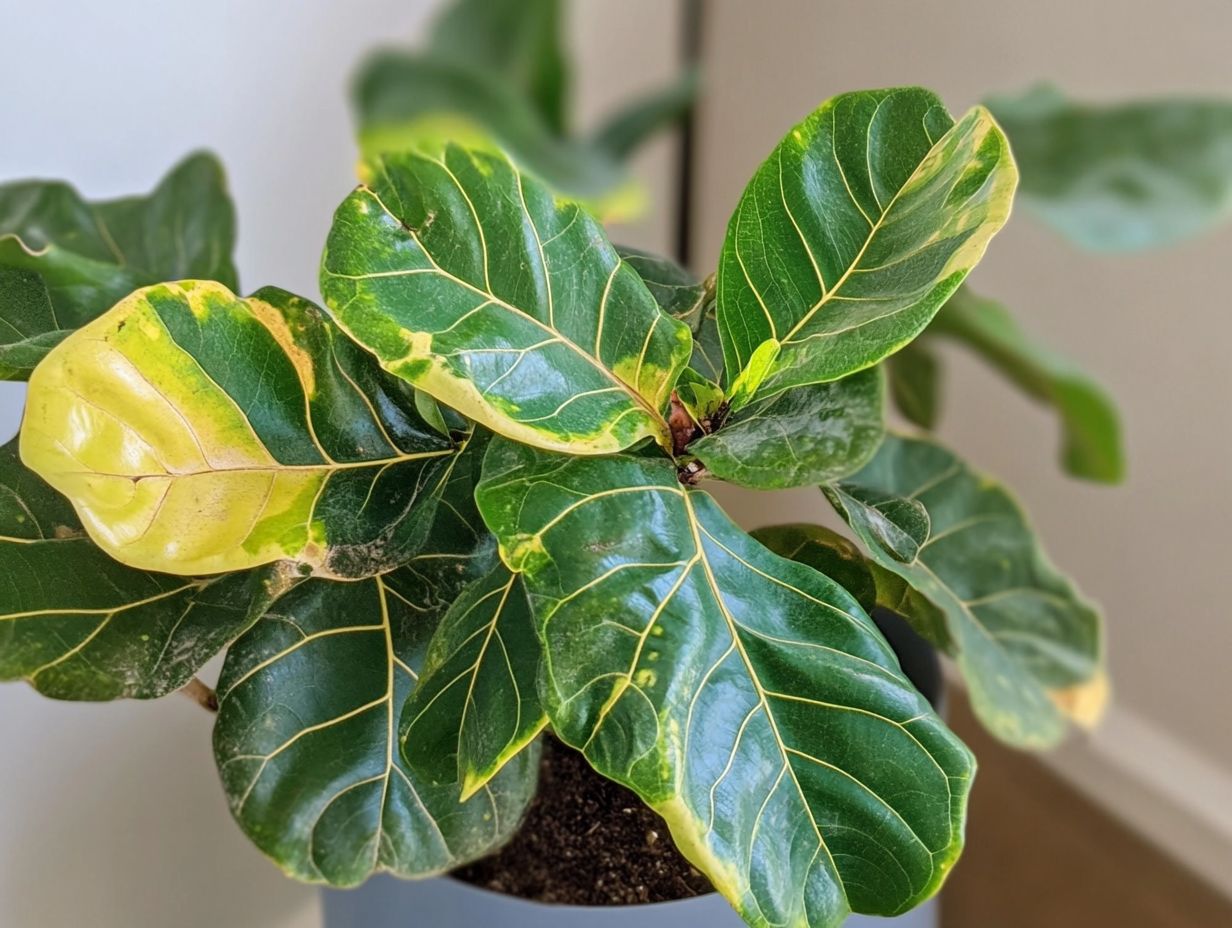
- Overwatering and underwatering are common issues with fiddle leaf figs. These can lead to root rot and nutrient deficiencies.
- Proper watering and nutrients are key to keeping fiddle leaf figs healthy and preventing leaf drop and yellowing leaves.
- Pests like spider mites and mealybugs, along with environmental factors like temperature and light, can affect fiddle leaf figs.
1. Overwatering
Overwatering is a common challenge for plant parents. It can lead to problems like leaf drop, yellowing leaves, and even root rot. Recognize the signs of overwatering to keep your plant healthy!
When your Fiddle Leaf Fig gets too much water, its roots can become saturated, preventing oxygen from reaching them and leading to decay. You’ll notice this unhealthy state manifesting as brown, mushy leaves that may eventually drop, creating an unappealing sight in your home.
To prevent overwatering, check the soil for dryness before watering. Using pots with adequate drainage holes allows excess water to escape, further protecting the roots from harm.
By understanding your plant s specific needs, including light and humidity levels, and avoiding direct sunlight, you ll be well on your way to fostering healthy growth and ensuring its longevity.
2. Underwatering
Underwatering is a crucial concern for you as a Fiddle Leaf Fig owner. It can lead to poor growth and visible signs of distress, like drooping leaves, which ultimately affect the overall health and aesthetic appeal of your magnificent indoor plant. Establishing a consistent watering routine is vital for maintaining adequate soil moisture levels.
When the soil dries out too much, your plant struggles to absorb essential nutrients, resulting in stunted growth and a weakened structure. To tackle this issue, check the top inch of soil for dryness it s a reliable guide. Water thoroughly until moisture seeps out of the drainage holes, allowing the roots to absorb water evenly.
By prioritizing consistent moisture, you not only support healthy foliage but also enhance the lush, vibrant appearance that defines Fiddle Leaf Figs.
Your Fiddle Leaf Fig deserves the best care! With these tips, it will thrive, so let’s get started!
3. Lack of Nutrients
A lack of nutrients can significantly impact the health of your Fiddle Leaf Fig. You might see yellowing leaves and stunted growth clear signs that call for your immediate attention as a devoted plant parent. Regular fertilization and knowing your plant s nutrient needs are crucial for maintaining lush foliage and vigorous growth.
You might encounter common deficiencies such as nitrogen, which often shows up as old leaves turning yellow and dropping off. Magnesium deficiency presents itself with notable yellowing between the veins of the leaves. Meanwhile, phosphorus deficiency can lead to darkened leaves and poor root development.
To address these challenges, consider using a balanced, water-soluble fertilizer during the growing season to breathe new life into your plant. Opting for nutrient-rich soil ensures that the roots have a steady supply of essential elements. This promotes recovery and encourages thriving growth.
Keep an eye on soil moisture to create an optimal environment for taking in nutrients.
4. Pests and Diseases

Pests and diseases can pose significant threats to the health of your Fiddle Leaf Fig. Common culprits like spider mites and mealybugs are ready to wreak havoc. These pesky intruders can lead to infestations that diminish the foliage and overall vitality of your Fiddle Leaf Fig. Act quickly to prevent damage with appropriate pest control measures.
To spot an infestation early, watch for webbing on the leaves or those tiny, white cottony spots; these are telltale signs that pests have moved in. If you notice yellowing leaves or speckled patterns, it might indicate a more serious problem lurking beneath the surface.
For treatment, consider using natural remedies like horticultural soap or neem oil. They are both effective and gentler on your plant and the environment.
Regularly inspecting your plant and maintaining optimal humidity levels can serve as essential preventive measures. Doing so creates a thriving habitat that your Fiddle Leaf Fig will thrive!
5. Environmental Factors
Environmental factors significantly influence the health and growth of your Fiddle Leaf Fig. These plants thrive under specific conditions, requiring adequate humidity levels and indirect sunlight. Understanding and replicating the ideal environment is essential to prevent common issues like leaf drop, poor growth, and disease.
To create the perfect habitat, place your plant near a bright window, but avoid direct sunlight, which can scorch those beautiful leaves. A location with filtered light or a sheer curtain can provide the necessary shade.
Maintaining humidity levels between 30% and 65% is crucial. You might consider using a humidifier or placing your Fiddle Leaf Fig on a pebble tray filled with water to achieve this. Regularly misting the leaves not only boosts humidity but also keeps dust at bay, enhancing the plant’s ability to photosynthesize.
With these simple adjustments, you can cultivate a thriving environment for your Fiddle Leaf Fig, ensuring plant recovery and growth.
How to Properly Care for a Fiddle Leaf Fig Plant?
Caring for a Fiddle Leaf Fig plant involves paying attention to several key factors, such as proper watering techniques, humidity levels, and timely pruning. As a plant parent, grasping these essential aspects of plant care is vital to preventing issues like leaf drop, yellowing leaves, and other distress signals that can undermine your plant’s overall well-being.
One effective watering technique is to allow the top inch of soil to dry out between waterings. This practice helps prevent root rot and encourages healthy growth. Additionally, maintaining humidity levels between 30% and 65% can significantly boost the plant’s vigor, as Fiddle Leaf Figs flourish in the humid environments they re accustomed to in their native habitats.
Regular pruning is equally important; it shapes the plant, promotes bushy growth, and removes any damaged leaves. This enhances airflow. By following these practices, you can dramatically enhance the longevity and beauty of your Fiddle Leaf Fig, transforming it into a stunning focal point in your home.
What Are the Best Practices for Watering a Fiddle Leaf Fig?
Implementing the right watering technique is essential for your Fiddle Leaf Fig care. Consistent soil moisture significantly influences the plant’s health, helping to prevent issues like leaf drop and root rot. Understanding your Fiddle Leaf Fig s specific watering needs ensures it thrives as an indoor gem.
To maintain optimal moisture levels, water your Fiddle Leaf Fig when the top inch of the soil feels dry to the touch. Check the soil weekly, especially during the growing season when the plant is most active.
You can use the finger test or a moisture meter (a tool that measures how wet the soil is) to accurately gauge the soil s hydration. When watering, pour until you see water draining from the bottom of the pot. This ensures even saturation while avoiding water pooling.
Be mindful: You definitely want to avoid overwatering; it can be more damaging than underwatering! A well-draining plant soil will help mitigate risks and maintain balanced moisture. For specific guidance on care, consider addressing common issues with snake plants. Rotate your plant regularly to promote even growth, as Fiddle Leaf Figs tend to lean toward light sources.
What Are the Most Common Nutrient Deficiencies in Fiddle Leaf Figs?

Understanding the most common nutrient deficiencies in Fiddle Leaf Figs is essential for any plant parent. These deficiencies often show up through symptoms like yellowing leaves and poor growth, impacting your plant’s overall vitality. For example, if your Fiddle Leaf Fig lacks nitrogen, you might notice stunted growth and pale foliage. A phosphorus deficiency could lead to darkened leaves and reduced blooming potential. Similarly, a potassium deficiency can restrict your plant s ability to retain moisture, causing leaf curling and browning at the tips.
To remedy these issues, select a balanced fertilizer that incorporates these key nutrients and apply it during the growing season. Also, enhancing the soil with organic matter improves nutrient retention and promotes better root health. This way, your Fiddle Leaf Fig thrives in a nourishing environment.
How Can One Identify and Treat Pests and Diseases in Fiddle Leaf Figs?
Identifying and treating pests and diseases in your Fiddle Leaf Figs is crucial for maintaining the health of your indoor garden. Insect infestations, such as spider mites and mealybugs, can wreak havoc if not addressed promptly. Recognizing the signs of these pests helps you take proactive measures for effective pest control.
Look out for common indicators like yellowing leaves, webbing on the undersides, and a sticky residue on the plant or nearby surfaces. To combat these threats, consider using neem oil or insecticidal soap; they can eliminate pests while being safe for your plants. Regularly inspect for signs of infestation and maintain humidity levels to stave off future issues.
Proper drainage and avoiding overwatering are essential preventive measures, as these conditions can create a welcoming environment for pests. For added protection, think about investing in diatomaceous earth. Sprinkling it around the base of your plant can deter various insects, and for more solutions, consider these 5 easy fixes for indoor plant issues, keeping your Fiddle Leaf Fig thriving.
What Are the Ideal Growing Conditions for Fiddle Leaf Figs?
Creating the perfect growing conditions for your Fiddle Leaf Figs requires understanding their love for bright, indirect sunlight. The right amount of humidity promotes healthy growth and vibrant foliage.
By ensuring these conditions, you not only elevate the aesthetic appeal of your indoor garden but also minimize common issues like leaf drop and lackluster growth.
To strike the right balance, position your Fiddle Leaf Figs near a window that offers filtered light; direct sunlight can scorch those delicate leaves. Maintaining humidity levels between 40-60% will work wonders, and you can achieve this by using a humidifier or placing a tray of water nearby. Additionally, be aware of the 5 common mistakes in indoor plant care to ensure your plants thrive.
Your Fiddle Leaf Figs prefer a cozy temperature range of 60-75 F. Keep them away from drafts or heating vents, as sudden temperature shifts can lead to stress. By monitoring these factors, you’ll cultivate a robust and attractive indoor environment for your beloved plants.
What Are Some Common Mistakes to Avoid When Caring for a Fiddle Leaf Fig?
Avoiding common mistakes in caring for your Fiddle Leaf Fig is essential for keeping it healthy. This helps prevent distress signals like leaf drop and yellowing leaves. Being mindful of these pitfalls enables you to make informed decisions about watering, pruning, and other care practices.
One of the most common blunders is overwatering, which can lead to root rot—the decay of roots caused by sitting in water too long—and the eventual demise of your beloved plant. To steer clear of this fate, ensure you let the top inch of soil dry out between waterings, as your Fiddle Leaf Fig thrives in drier conditions. For more tips, check out this quick guide to common indoor plant issues.
Another frequent misstep is insufficient light exposure. By providing your plant with bright, indirect sunlight, you can significantly enhance its growth and vitality. Don t forget pest control; ignoring it can lead to infestations that stunt your plant.
Make it a habit to regularly inspect the leaves for signs of unwelcome guests like spider mites or mealybugs. This proactive approach will help maintain a thriving environment. By understanding the 5 common mistakes in houseplant care and implementing thoughtful care strategies, you can watch your Fiddle Leaf Fig thrive, bursting with lush beauty that’s sure to impress!
Frequently Asked Questions
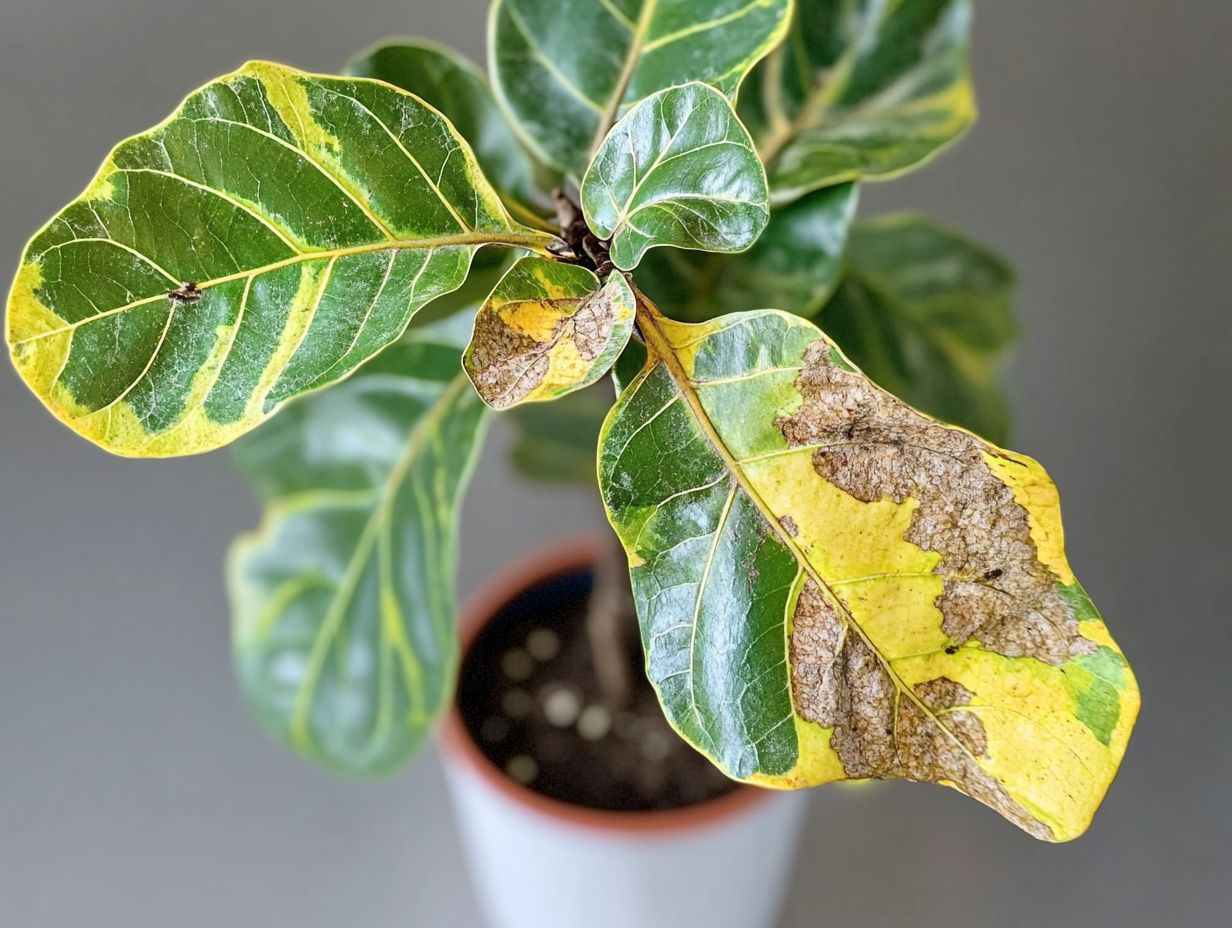
-
What are the most common issues with fiddle leaf figs?
The five most common issues with fiddle leaf figs are yellowing leaves, brown spots, dropping leaves, root rot, and pests.
-
Why are my fiddle leaf fig’s leaves turning yellow?
Yellowing leaves on a fiddle leaf fig can be caused by overwatering, underwatering, lack of sunlight, or a nutrient deficiency.
-
How can I prevent brown spots on my fiddle leaf fig’s leaves?
Brown spots on fiddle leaf fig leaves can be prevented by avoiding overwatering, ensuring proper drainage, and regularly dusting the leaves to prevent dust buildup.
-
Why is my fiddle leaf fig dropping leaves?
Fiddle leaf figs can drop leaves due to stress from changes in environment, over or underwatering, lack of sunlight, or pest infestations.
-
What should I do if my fiddle leaf fig has root rot?
If your fiddle leaf fig has root rot, you should repot it in fresh soil and trim off any damaged roots. Make sure to also adjust your watering habits to prevent future root rot.
-
How can I get rid of pests on my fiddle leaf fig?
Pests such as mealybugs, spider mites, and scale can be treated with a gentle insecticidal soap or neem oil. Be sure to thoroughly cover all surfaces of the plant, including under the leaves.
Got more questions? Let us know in the comments below!

